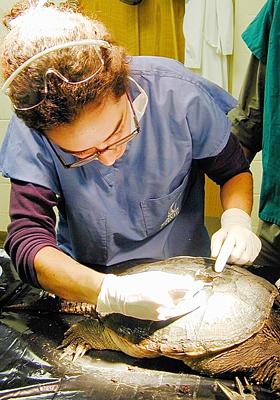“Meatwad” is a male eastern painted turtle who had an unfortunate run-in with a dog Tuesday afternoon.
The turtle lost about a third of his lower shell in the encounter and might have died if the dog’s owner hadn’t brought him to the turtle rescue team at the College of Veterinary Medicine.
The team cleaned dog hair and debris from the turtle’s wounds and today layers of stretchy green tape and clean white gauze hide his injured shell.
Meatwad may be a little dazed – he is, after all, on painkillers and antibiotics, but he’s safely away from dogs and the prospect for his release this summer looks good.
“To a dog, turtles are like living, moving rawhide,” Shane Christian, aquatic animal research technician and turtle team coordinator, said. “Maybe they try to get away a little bit, and dogs will bark at them and chew on them.”
CBD, or “chewed by dog,” is the second most prominent cause of injury of turtles brought to the turtle rescue team.
The leading cause of injury, accounting for about two thirds of the cases, is “vehicular trauma,” according to Greg Lewbart, the turtle team’s faculty adviser and professor of aquatic animal medicine in the Department of Clinical Sciences.
The team treats about 150 turtles per year with about a 65 percent release rate.
“We try to release the turtles near where they came from, always in the county of origin,” Lewbart said. “We always take them somewhere safe, and we won’t release a turtle that’s not viable or that is reproductively compromised.”
The busy season for turtle rescue starts in May and peaks in July and September when turtles are crossing roads to look for mates and nest sites, he added.
The turtle rescue operation at N.C. State hasn’t always been this big.
When Lewbart came to the University in 1993 he treated a few turtles per year and students often helped, but mostly he referred turtle cases to Linda Henis, a local wildlife rehabilitator.
When Henis moved from the area in 1997 she left a donation in her father’s name to establish an official turtle rescue team at the vet school.
Lewbart saw an educational opportunity, and, together with a core group of students, began to raise additional funds and treat turtles.
The team saw about 50 turtles in its first year and word of its services spread rapidly. Police departments, animal control agencies and private veterinarians began to refer injured turtles to the team, and, during a busy year, work with up to 275 turtles.
Thirty to 40 veterinary students participate in the turtle team each year. They are organized into four units that take turns managing the turtle hospital and carrying the on-call pager.
“Our main mission and our main contribution is educational,” Lewbart said. “If you were really worried about turtle populations, you’d focus on habitat protection. But with turtle team, students learn to start acting like doctors before they really are doctors.”
Vet students can start working on the turtle team in the first year; without the turtles, they might not get real clinical experience until the fourth year.
“Turtle team is one of the best educational experiences you get before clinical rotations,” Jodi O’Brien, third year vet student and co-president of the turtle team, said. “It’s great for students because we get to do the anesthesia and the surgeries ourselves; we learn to do all our charts – we really know what we’re doing before we get to rotations.”
According to students in the program, working with turtles is also rewarding in its own right.”They’re just amazing animals,” O’Brien said.
O’Brien didn’t see Meatwad for the first time until after he was fully bandaged, so she had some questions about his condition.
She asked Christian if the turtle had any of its organs hanging out.
All of Meatwad’s organs are where they belong, but it’s not unusual for injured turtles to spill their guts. “Turtles will come in with their spinal cord cut, or maybe you’re looking at their brain, their lung, their gut, and still, they recover,” Lewbart said.
Such internal injuries are treatable, but the team does more shell stabilization than anything else. They use screws and wires or casts to reunite the pieces of a crushed or broken shell.
“A broken shell is like a loose puzzle,” O’Brien said. “You just have to put the pieces back together.”Pieces of a broken shell can knit back together, but detached pieces cannot be replaced. Instead, tough, leathery scar tissue covers areas of missing shell.
The various treatments consume about $100 worth of supplies per turtle – including shell repair materials, fluids, medicines, food and clinical services.
Because shell repair materials can be reused, and because food and supplies are often donated, the team gets by on about $45 per animal, Christian said. This keeps the team well within its annual budget of about $7,000, which is funded by private donations.
The team welcomes student volunteers, and interested parties are encouraged to contact Lewbart at greg_lewbart@ncsu.edu.








